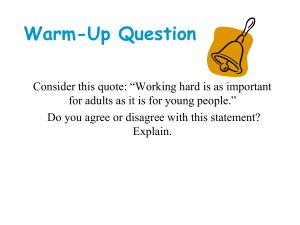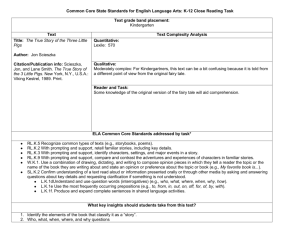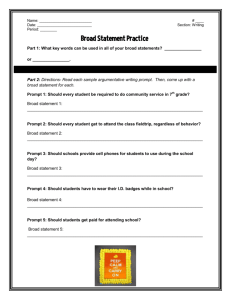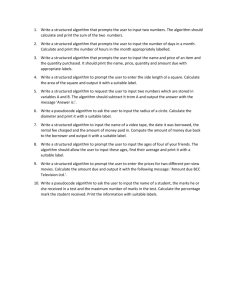Give a RARE Response!
advertisement
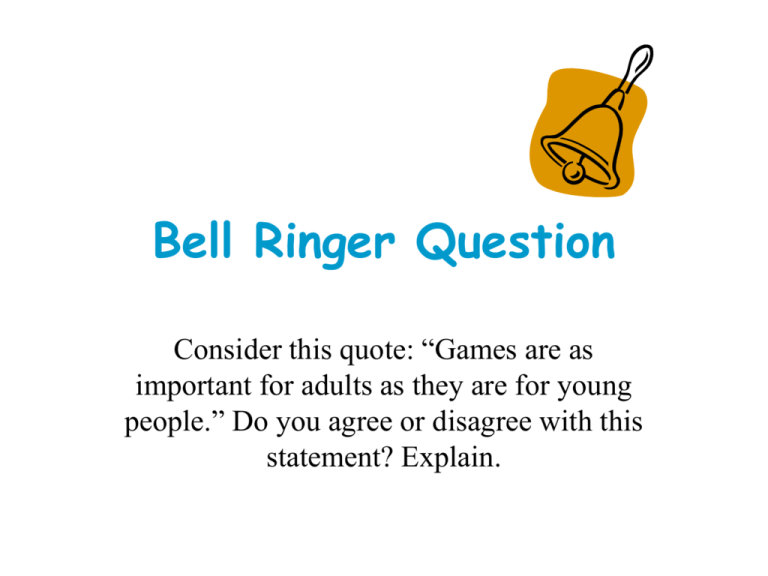
Bell Ringer Question Consider this quote: “Games are as important for adults as they are for young people.” Do you agree or disagree with this statement? Explain. Just the Facts, please… •With a partner, analyze St. Amant High School’s GEE data. •Highlight or star two things that stand out to you and discuss with your partner. What do you notice? • Students perform much better on multiple choice items. • Constructed Response scores are a good bit lower than multiple choice scores. WHY do you think this occurs? • What can we do about it? A RARE response = Better Answers How to Sound Smart Answering Constructed Response Questions RARE Strategy 4-part strategy that, if used often, TRAINS YOUR BRAIN to think about the most important steps in answering a question! Restating, Answering, Reasoning, Evidence Types of Prompts • Text-based (you find the answer in the reading or your knowledge of a topic; student answers will be similar) – List and explain three different types of learning styles. • Self-based (your opinion, prediction, beliefs, etc. Answer comes from your head, and all student answers will be different) – What do you do to prepare for exams? Partner Chat Why would it be important to differentiate between textbased prompts and self-based prompts? Prompt components • Background information – previously learned or provided in question • Prompt petitions – part of the prompt that tells you to do something rather than asks a question (explain, predict, describe, analyze, rate, compare, contrast, define) • Prompt questions – specifically asks a question and ends with a question mark. (Why does…? How could…? Which might…?) Partner Chat 1. Why is reading background information important when answering a CR question? 2. Which kind of prompt, petitions or questions, do you think students perform better on? Why? 3. How do you respond differently to a petition prompt than you do to a question prompt? General Reminders • Don’t start your answer off with “Yes,” “No,” “I believe,” or “I think.” • The response should make sense even WITHOUT the prompt. The smartestsounding responses can stand alone! • Don’t change nouns to pronouns in the first sentence. Before you write… • Dissect your prompt – Underline or put a star next to background information and circle petitions or questions. – Decide boundaries of response – is it text-based or self-based? – Try it out. Dissect the following prompt. Consider this quote: “Games are as important for adults as they are for children.” Do you agree or disagree with this statement? Think Aloud Recall with your partner the story of the Three Little Pigs. Respond to this question: The wolf in The Three Little Pigs says that everyone has him wrong. He’s really a nice wolf. Do you believe him? R = Restate • Restate the question. Use words from the prompt; use the correct transition words (because, by, to, when); don’t replace nouns with pronouns. • Typical Answer: No I don’t believe him. • Better Answer: The wolf in The Three Little Pigs is anything but nice. Why didn’t we start with, “No, I don’t believe him…”? A = Answer • Answer the question with a gist summary (main idea but no details yet, just like a topic sentence or thesis statement) • Typical Answer: No, I don’t believe him. He’s gangsta. • Better Answer: The wolf in the story The Three Little Pigs is anything but nice. In fact, he is best described as aggressive and mean. R = Reasons from the Text • Provide reasons to support your answer with details from the text. • Typical Answer: No, I don’t believe him. He’s gangsta. The way he had those pigs so scared. • Better Answer: The wolf in the story The Three Little Pigs is anything but nice. In fact, he is best described as aggressive and mean because he was relentless in trying to eat the three innocent pigs. • • • E = Examples, Evidence, Explanation or Elaboration and Ending Provide examples, evidence, explanation, or elaboration from the text/your mind to support your answer. Typical Answer: Students usually leave this part out! Answer: The wolf in the story The Three Little Pigs is anything but nice. In fact, he is best described as aggressive and mean because he was relentless in trying to eat the three innocent pigs. For example, he chased them from house to house and made them run for their lives. He also destroyed two of the pigs’ homes in the process. That wolf has a lot to learn about being nice. Questions about RARE • Think about the format of CR answers. Will every response be exactly four sentences long? Why or why not? • Why do you think teacher-made assessments and standardized tests include Constructed Response items? • What is the most difficult part of RARE? Why? Back to our question… Consider this quote: “Games are as important for adults as they are for young people.” Do you agree or disagree with this statement? On your own, develop a RARE response. RARE checklist and rubric • Compare your revised, RARE answer to the answer you first provided. Does your new answer sound smarter? Congratulations! • Now evaluate your partner’s answer using the RARE checklist and the rubric provided. • Compare rubrics. How did you do?
